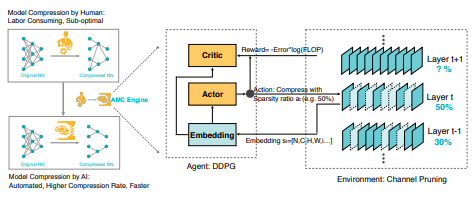AMC-AutoML for Model Compression and Acceleration of Mobile Devices
An overview of the paper “AMC: AutoML for Model Compression and Acceleration of Mobile Devices”. This paper proposes a novel compression algorithm which allows us to efficiently deploy neural network models on mobile devices, etc. All images and tables in this post are from their paper.
Previously, models were compressed using hand-crafted heuristics and rule-based policies that require domain expert knowledge. Their algorithm is automated and less time consuming than others of the same kind. They create a reinforcement learning model called DDPG which penalizes accuracy loss while encouraging model shrinking and speedup. This agent works in a layerwise manner.
AMC
The AMC algorithm can be broadly broken down into 3 different parts as follows.
Overview of AutoML for Model Compression (AMC) engine.

Compression strategy
Two types of pruning strategy are experimented with in this work. The fine-grained pruning strategy prunes unimportant values in the weights or the weights with least magnitude. Coarse-grained pruning refers to dropping entire channels,rows or columns.
Policy gradient RL
For this section, the deep deterministic policy gradient(DDPG) is employed. The state space is defined by 11 different features for layer
, where
is layer index. Before being passed to the agent, they are scaled with
. The agent receives an embedding state
of layer
from the environment and then outputs a sparsity ratio as action
. The underlying layer is compressed with
using a specified compression algorithm. Then the agent moves to the next layer
, and receives state
. After finishing the final layer
, the reward accuracy is evaluated on the validation set and
returned to the agent.
Reward function
Based on the constraint, the reward function is given as follows:
In resource constrained optimization, we do not use a constraint. i.e. . For instance, in fine-grained pruning, a is allowed to take any value for the first few layers, and later limits a, allowing an agent to achieve a target compression ratio.
In accuracy constrained optimization, we use FLOPs, #params and latency in the reward function as defined earlier.This also shows that any type of metric: proxy(FLOPs, #params) and real-time(latency) can be plugged in.
The paper goes on to provide clear experimental results on CIFAR-10 and a subset of ImageNet which clearly explain the performance boost over all previous research works.
